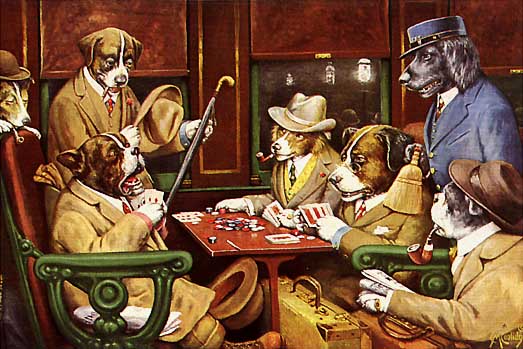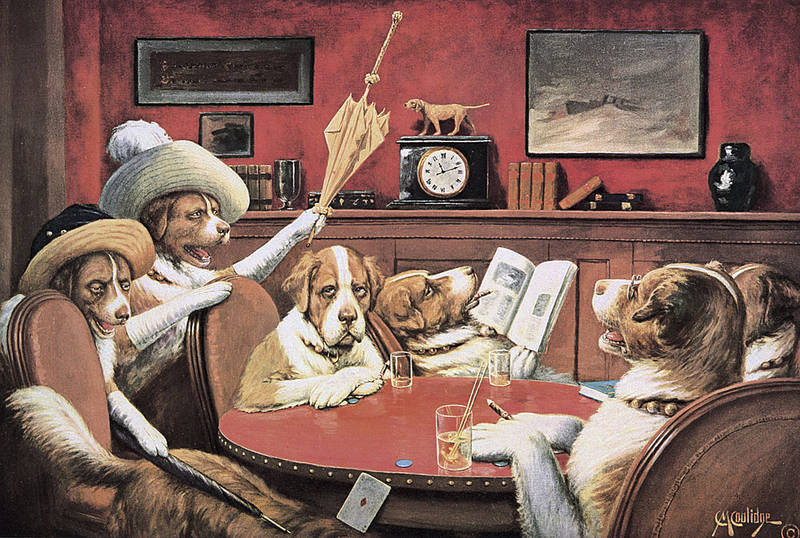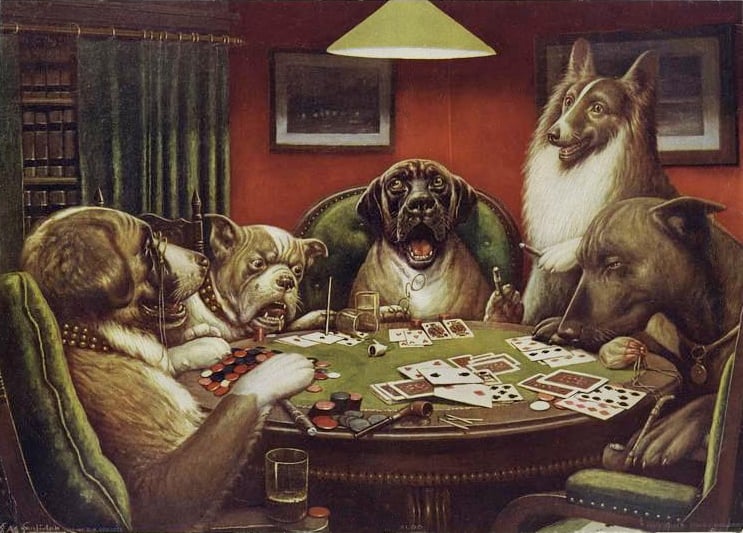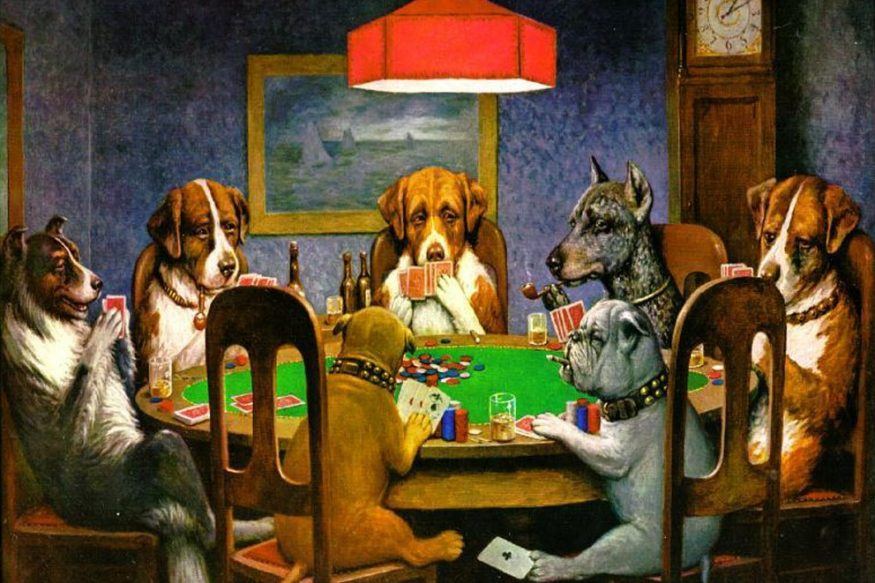
The Story Behind The Iconic “Dogs Playing Poker” Painting
Cassius Marcellus Coolidge’s illustrations of canines gathered around poker tables are instantly recognizable, not only among gambling enthusiasts but across the cultural landscape. While often referenced as a single work, “Dogs Playing Poker” is actually an entire series that has transcended its humble origins to become an American icon. This article explores the history, significance, and ongoing appeal of these playful paintings.
Tracing the Origins: How “Dogs Playing Poker” Was Created
The collection known as “Dogs Playing Poker” consists of 18 paintings, crafted between the late 19th and early 20th centuries by US artist Cassius Marcellus Coolidge. Characterized by anthropomorphic dogs engaging in very human scenarios, these paintings blur the line between comic illustration and fine art. While 11 of the pieces specifically showcase dogs immersed in poker games, the whole series features dogs in a variety of amusing situations.
Commissioned primarily as advertising for the Brown & Bigelow cigar company, 16 of Coolidge’s works in this series were not initially regarded as traditional art. Instead, they functioned as promotional material, decorating calendars meant for mass appeal. Despite this, they ultimately carved out a unique niche in American visual culture.
The earliest work in the collection, titled Poker Game, dates to 1894 and quickly became synonymous with the broader “Dogs Playing Poker” brand. The painting known as A Friend in Need is another standout, notorious for its sly depiction of one dog covertly passing an ace under the table to assist his companion.
Inside the Brown & Bigelow Series: A Closer Look at 16 Memorable Paintings
Coolidge’s cigar ad series is especially notable for its creativity and humor, featuring an array of canine antics. Here’s a glimpse into each of the 16 paintings belonging to the Brown & Bigelow collection:
- A Bachelor’s Dog: Features a comfortably lounging dog with a cigar, beer, mail, and newspaper, embodying a leisurely lifestyle.
- A Bold Bluff: Showcases a St. Bernard attempting to deceive his fellow players with a weak poker hand as the others eye him intently.
- Breach of Promise Suit: Depicts a courtroom drama centered on a broken doggy engagement.
- A Friend in Need: Perhaps the most famous image in the whole series, with a clandestine card-passing moment at a smoky poker table.
- His Station and Four Aces: A train conductor passes a game in progress among smartly dressed dog passengers.
Image: Wikimedia Commons
- New Year’s Eve in Dogville: Canine revelers fill a party with music and dance for a New Year celebration.
- One to Tie Two to Win: A lively stadium scene where fans cheer on a dog baseball game.
- Pinched with Four Aces: Poker-playing pooches are surprised by a police raid in a shadowy room.
- Poker Sympathy: In the midst of play, one dog tumbles off his seat, spilling cards and drink to the amusement of the rest.
Image: Wikimedia Commons
- Post Mortem: Three dogs relax with snacks, drinks, and, naturally, a round of poker.
- The Reunion: Four collies gather over cigars and glasses in a cozy bar setting.
- Riding the Goat: A costumed jester dog entertains a royal couple, with a blindfolded dog atop a goat for comedic effect.
- Sitting up with a Sick Friend: A supposed illness is revealed as a cover for a male gathering when a group of female dogs investigates.
Image: Wikimedia Commons
- Stranger in Camp: A campfire poker session is disrupted by a particularly unlucky hand.
- Ten Miles to a Garage: Stranded on the roadside, a pack of dogs faces automotive woes.
- A Waterloo: A dramatic hand ends in triumph for a cunning bluffer, shocking the other players.
Image: Wikimedia Commons
From Art to Icon: “Dogs Playing Poker” in Pop Culture
Over the decades, “Dogs Playing Poker” has far surpassed its beginnings as a clever promotional campaign to become a pop culture mainstay. Its lively depictions of canine card players have graced everything from television sets to clothing lines, becoming a recurring motif across entertainment and merchandise.
The paintings have been humorously referenced in animated series such as The Simpsons, Family Guy, and children’s shows like Courage the Cowardly Dog. Sitcoms including Cheers and Roseanne have made playful nods to the series as well.
This collection’s whimsical energy has even inspired lyrics in popular music and continues to be a beloved theme for art prints and home décor.
The Life and Artistry of Cassius Marcellus Coolidge
Cassius Marcellus Coolidge, born in Antwerp, New York, in 1844, led an inventive and varied life. Raised on a family farm, Coolidge explored multiple professions including sign painting, banking, and newspaper publishing before discovering his unique artistic niche.
With little formal training, Coolidge moved to Rochester in the 1870s and began illustrating, focusing on caricatures and eventually settling on his signature motif: dogs engaged in human activities. His lighthearted artworks quickly found an audience, and Coolidge often signed paintings with the family nicknames “Cash” or “Kash.”
Apart from his paintings, Coolidge is acknowledged as the creator of the “comic foreground” or carnival cutout - those painted boards with face holes for whimsical photographs, which also served as a key income stream for him.
The Changing Value and Perception of “Dogs Playing Poker”
For much of the 20th century, Coolidge’s work was dismissed as kitsch by the fine art establishment, failing to command high prices or critical praise. Nevertheless, the accessibility and humor of the paintings won them a broad fanbase.
In recent years, attitudes have shifted and Coolidge’s paintings now attract significant attention and value at auction:
- Poker Game set a record when it was sold in 2015 for $658,000.
- A pair consisting of A Bold Bluff and Waterloo realized a price just above $590,000.
- Though A Friend in Need is cited as his most valuable work, it remains privately held and is thought to be worth several million dollars.
Despite previous derision-such as the 2002 prank by art historian William Hennessey, who pretended his museum pursued Coolidge’s work-the artist’s legacy is now better appreciated for its contribution to American culture.
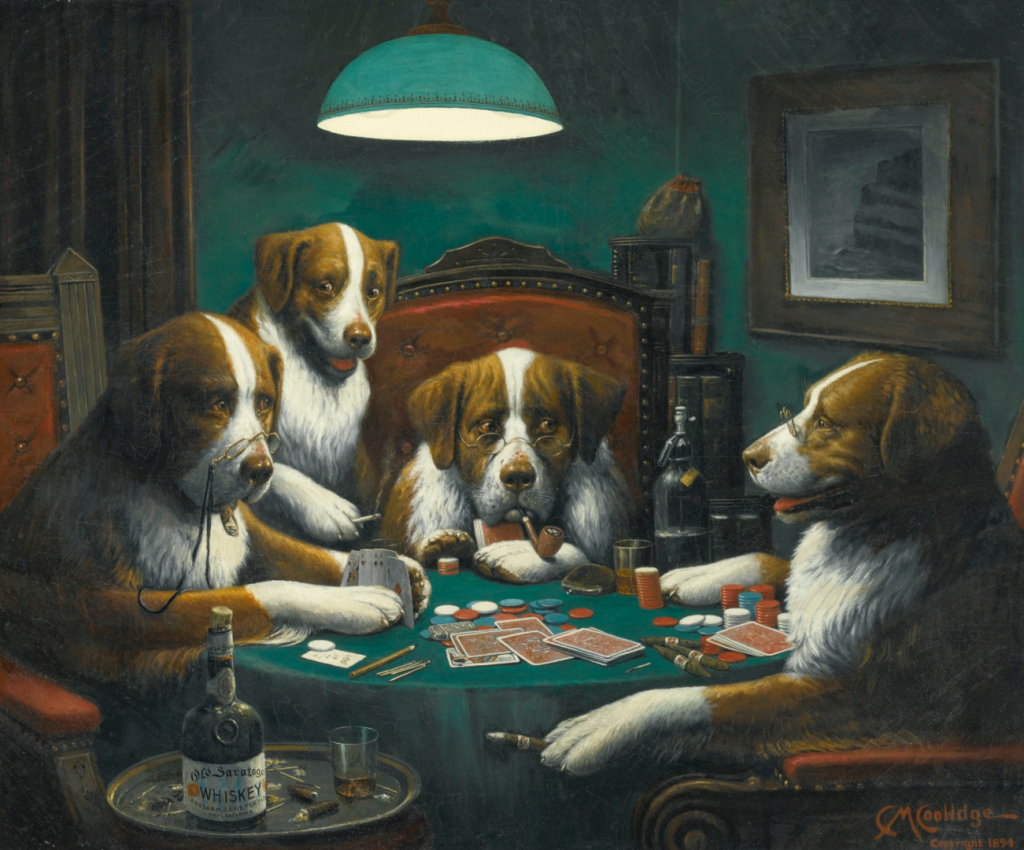
How to Acquire “Dogs Playing Poker” Art for Your Space
While original Coolidge paintings are rare collector’s pieces commanding high figures at auction, there are countless ways to enjoy this celebrated art series. High-quality prints-ready for framing or display-are available through multiple online retailers including Amazon and Etsy.
For those seeking a truly unique statement piece, hand-painted reproductions by talented artists are also offered at numerous online galleries. While these cost more than regular prints, they offer museum-level quality suitable for stylish home or office decor.
Conclusion: A Playful Legacy Endures
What began as a quirky set of advertisements has grown into a cultural legend. “Dogs Playing Poker” continues to charm audiences and collectors a century after its creation, symbolizing the power of art that makes us smile and see the familiar in a whole new light.

